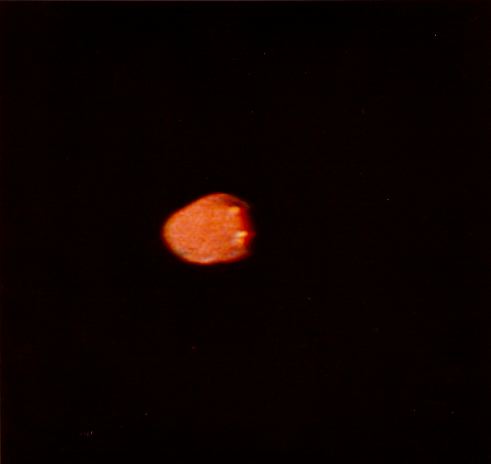 This is the Web Edition of "A Trip Into Space", a Coimbra-based electronic book on space science. Both the texts and the photos are by courtesy of National Aeronautics and Space Administration.
This is the Web Edition of "A Trip Into Space", a Coimbra-based electronic book on space science. Both the texts and the photos are by courtesy of National Aeronautics and Space Administration.
 This is the Web Edition of "A Trip Into Space", a Coimbra-based electronic book on space science. Both the texts and the photos are by courtesy of National Aeronautics and Space Administration. This is the Web Edition of "A Trip Into Space", a Coimbra-based electronic book on space science. Both the texts and the photos are by courtesy of National Aeronautics and Space Administration.
|
A Trip Into Space  Jupiter Jupiter  Satellites Satellites  Jupiter's Satellite Amalthea Jupiter's Satellite Amalthea |
|
| See also: Jovian Satellite Fact Sheet |   |
Tiny, red Amalthea, Jupiter's innermost satellite whizzes around the planet every 12 hours, only 1.55 Jupiter radii from the cloud tops. In this view taken from a range of 255,000 miles (425,000 kilometers) on March 4 by Voyager 1, the satellite appears about 80 miles (130 kilometers) high by 100 miles (170 kilometers) wide. Since the phase angle is 29 1/4, part of the longer dimension is not illuminated. The terminator is on the right, north is at top, Jupiter is to the left. The reflectivity of the surface is less than 10%, making Amalthea much darker than the Galilean satellites. Amalthea's irregular shape probably results from a long history of impact cratering. Some of the indentations near the bottom and at upper right may be marginally resolved craters. The effective resolution of this image is about 5 miles (8 kilometers). An important question is whether the red color is characteristic of the bulk of Amalthea, or whether, as is more likely, it results from a coating or alteration of the surface material. This irregular satellite probably keeps its long axis pointed toward Jupiter in its motions around the planet so that the spin period around its own axis equals its period of revolution around Jupiter (12 hours). Unlike the four large Galilean satellites which have been known since 1610, Amalthea was discovered only 87 years ago, in 1892, by the American astronomer Edmund Emerson Barnard at Lick Observatory. JPL manages and controls the Voyager project for NASA's Office of Space Science.

Last Update: 2004-Nov-27